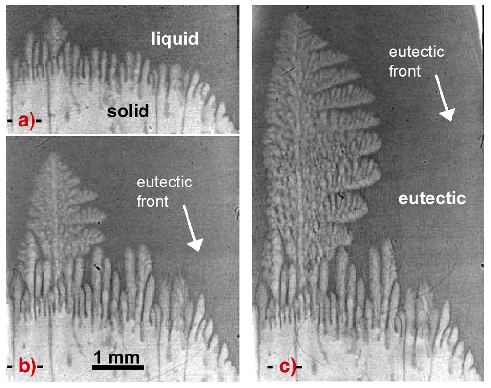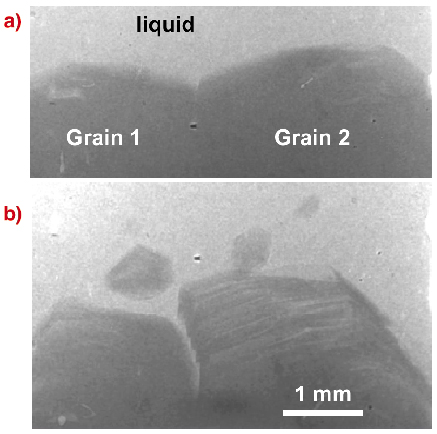- Home
- Users & Science
- Scientific Documentation
- ESRF Highlights
- ESRF Highlights 2004
- X-ray Imaging
- Application of Synchrotron X-ray Imaging to the Study of Directional Solidification of Aluminium-based Alloys
Application of Synchrotron X-ray Imaging to the Study of Directional Solidification of Aluminium-based Alloys
The properties of materials elaborated from the melt are largely governed by the microstructure built into the solid during processing. Materials engineering aims to devise materials and processing conditions that would give optimum properties and better reliability.
It is therefore essential to have a precise understanding of solidification pattern formation to be able to achieve new technological breakthroughs. Directional solidification has become the method of choice to study microstructure formation since the process parameters (pulling velocity V, temperature gradient G, alloy composition) are independently and accurately controlled, and the response of the interface quantitatively examined through the evolution of the solid liquid interface morphology (smooth ![]() cells
cells ![]() dendrites as growth rate increases). For metallic alloys, third-generation synchrotron X-ray sources allow in situ and real-time X-ray imaging with high spatial and temporal resolution. Using absorption and phase contrast radiography, we present two examples of dynamical pattern formation in thin Al-based alloys solidified from the bottom upwards in the specific Bridgman facility[1] installed at the ID19 beamline.
dendrites as growth rate increases). For metallic alloys, third-generation synchrotron X-ray sources allow in situ and real-time X-ray imaging with high spatial and temporal resolution. Using absorption and phase contrast radiography, we present two examples of dynamical pattern formation in thin Al-based alloys solidified from the bottom upwards in the specific Bridgman facility[1] installed at the ID19 beamline.
Figure 139 displays the dynamical interaction between dendrite formation and buoyancy-driven convection, common in casting and welding. After the breakdown of the smooth solid liquid interface, the corrugations progressively increase in amplitude and sidebranches begin to show up on the largest ones (Figure 139a), which indicates the inception of dendrites [2]. Fluid flow in the melt induces significant solute accumulation and a transition to a eutectic pattern on the right of Figure 139b, and localisation of dendritic growth on the left. Neighbour screening eventually results in the coupled growth of a large single dendrite, protruding into the liquid, far ahead of the eutectic at its base (Figure 139c).
 |
|
Fig. 139: Formation of the dendritic microstructure in Al-3.5 wt% Ni. V = 1 µm/s, G = 20 K/cm, thickness = 250 µm. a) 1344 sec after birth of morphological instability; b) t = 3206 sec; c) t = 4254 sec. |
To the best of our knowledge, Figure 140 provides the first direct evidence of the facetted character of the growth of icosahedral quasicrystals from an Al72.4Pd20.5Mn7.1 melt. Indeed, quasicrystals still keep us wondering, particularly about how orientation order progresses over such long distance during their growth. In Figure 140a, two facet edges are visible on grain 1 and three on grain 2, and there is a narrow cusp at the level of the grain boundary. When the applied pulling rate is increased to 3.6 µm/s, the cusp evolves into a deep, wide liquid groove, and the facets exhibit salient evidence of layer-motion controlled growth (Figure 140b). Possibly due to the skeletal instability of layer motion [3], striations run parallel to the interface and notches form repeatedly on the left side of grain 2. After a while, new grains nucleate and grow facetted in the liquid just above the two initial grains, whose growth becomes blocked.
 |
|
Fig. 140: Steady-state growth of AlPdMn quasicrystal grains at 0.4 µm/s (a), and evolution of the two initial grains at the beginning of their screening by new grains 750 s after increasing the pulling rate to 3.6 µm/s (b). Sample thickness = 500 µm. |
In conclusion, the dynamics of pattern formation in solidification of alloys can be efficiently probed in situ and in real-time, and detailed information can be obtained. Firstly, it is demonstrated that, under fluid flow, the competition with eutectic microstructure results in dendrite localisation. Secondly, the first live observation of the solidification of quasicrystal grains provides sound proof of facetted growth. By filling part of the huge deficit in the knowledge of the physical mechanisms active in quasicrystal growth, reliable guidance is provided for further advancement of the theoretical modelling.
References
[1] H. Nguyen Thi et al., J. Phys. D: Appl. Phys. 36, A83 (2003).
[2] R.H. Mathiesen et al., Phys. Rev. Lett. 83, 5062 (1999).
[3] A.A. Chernov, J. Crystal Growth 24/25, 11 (1974).
Principal Publication and Authors
T. Schenk (a), H. Nguyen Thi (b), J. Gastaldi (c), G. Reinhart (b), V. Cristiglio (a), N. Mangelinck-Noël (b), H. Klein (d), J. Härtwig (a), B. Grushko (e), B. Billia (b), J. Baruchel (a), J. Crystal Growth, in press.
(a) ESRF
(b) L2MP, Marseille (France)
(c) CRMCN, Marseille (France)
(d) Laboratoire Cristallographie, CNRS, Grenoble (France)
(e) IFF, Forschungszentrum Juelich (Germany)



